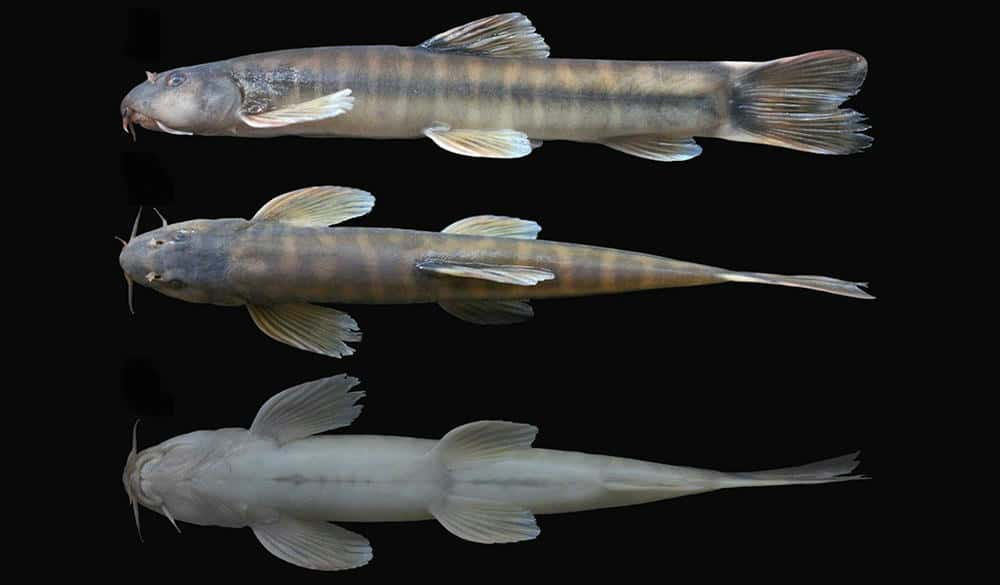Eyes in the dark: New Meghalaya cave fish defies evolutionary rules

Deep in the limestone belly of Meghalaya, scientists have discovered a fish that shouldn’t exist — at least not the way it does. Meet Schistura densiclava, a rare new species found living in near-total darkness inside a remote cave — and yet, it can still see.
In a major boost for India’s subterranean biodiversity profile, researchers from Gauhati University, Lady Keane College (Shillong), and the ICAR-National Bureau of Fish Genetic Resources (Lucknow) have identified a previously unknown species of stone loach in Krem Mawjymbuin, a limestone cave near Mawjymbuin village, just 15 km from Mawsynram, one of the wettest places on Earth.
“This discovery highlights the untapped biodiversity thriving in Meghalaya’s underground ecosystems,” said Prof Dandadhar Sarma, Head of Zoology at Gauhati University. “It’s the ninth new species we’ve described from the Northeast, and the sixth cave-associated fish known from Meghalaya.”
But this fish breaks the cave-dwelling mold. While most hypogean species evolve to lose their eyes and pigmentation — trading vision for other senses — Schistura densiclava retains both. It sports a pale yellow-green body with 14–20 bold black bars and a signature thick stripe near the dorsal fin — the feature that earned it the Latin name densiclava, meaning “thick stripe.”
The discovery was officially published in the Journal of Fish Biology, a prestigious peer-reviewed publication of the Fisheries Society of the British Isles.
Unlike its more famous cousins — like Schistura papulifera or Neolissochilus pnar, which have evolved into full-blown troglobites with zero pigmentation or eyesight — S. densiclava is a troglophile. That means it’s capable of living inside caves, but hasn’t fully adapted to the extremes. However, field researchers report that this species appears restricted to the cool, fast-flowing stream about 60 meters inside the cave — suggesting a possible evolutionary transition is in progress.
At 18°C, the cave water is cold and oxygen-poor. Yet the loach is thriving — feeding on a bizarre diet that includes tiny shrimp, insect remains, copepods, and even bat guano. The find underscores how opportunistic and resilient lifeforms can be in nutrient-scarce environments.
“The fish shows clear sexual dimorphism,” said Kangkan Sarma, a lead author of the study. “Males are slimmer, with irregular patterns and puffier cheeks, while females are more robust and show uniform markings. DNA sequencing confirms that this is a completely new species, genetically distinct from other Schistura species in the region.”
Krem Mawjymbuin, nestled deep in the East Khasi Hills, remains largely unexplored. Access is difficult and seasonal, and the dense forest surrounding the cave has kept it shielded from tourism and development. Researchers report no visible human impact within the cave — a rarity in today’s rapidly changing ecological landscape.
Meghalaya has long been hailed as a global cave biodiversity hotspot, with hundreds of caves still unstudied. With this discovery, the number of known cave fish in the state has risen to six — three of which have been described by Gauhati University alone.
In a post on social media platform X (formerly Twitter), Assam Education Minister Ranoj Pegu congratulated the team: “Delighted to learn about the discovery of a new troglophilic loach species, Schistura densiclava. A proud moment for Northeast India’s scientific community.”
The discovery of S. densiclava is more than a new name in taxonomy — it’s a symbol of what lies beneath. Beneath the forest canopy. Beneath the limestone crust. Beneath the radar of conventional science. It’s a reminder that the darkest places can hold the brightest revelations.






Leave a Reply